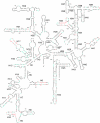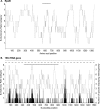Use of 16S rRNA and rpoB genes as molecular markers for microbial ecology studies
- PMID: 17071787
- PMCID: PMC1797146
- DOI: 10.1128/AEM.01177-06
Use of 16S rRNA and rpoB genes as molecular markers for microbial ecology studies
Abstract
Several characteristics of the 16S rRNA gene, such as its essential function, ubiquity, and evolutionary properties, have allowed it to become the most commonly used molecular marker in microbial ecology. However, one fact that has been overlooked is that multiple copies of this gene are often present in a given bacterium. These intragenomic copies can differ in sequence, leading to identification of multiple ribotypes for a single organism. To evaluate the impact of such intragenomic heterogeneity on the performance of the 16S rRNA gene as a molecular marker, we compared its phylogenetic and evolutionary characteristics to those of the single-copy gene rpoB. Full-length gene sequences and gene fragments commonly used for denaturing gradient gel electrophoresis were compared at various taxonomic levels. Heterogeneity found between intragenomic 16S rRNA gene copies was concentrated in specific regions of rRNA secondary structure. Such "heterogeneity hot spots" occurred within all gene fragments commonly used in molecular microbial ecology. This intragenomic heterogeneity influenced 16S rRNA gene tree topology, phylogenetic resolution, and operational taxonomic unit estimates at the species level or below. rpoB provided comparable phylogenetic resolution to that of the 16S rRNA gene at all taxonomic levels, except between closely related organisms (species and subspecies levels), for which it provided better resolution. This is particularly relevant in the context of a growing number of studies focusing on subspecies diversity, in which single-copy protein-encoding genes such as rpoB could complement the information provided by the 16S rRNA gene.
Figures




References
-
- Acinas, S. G., V. Klepac-Ceraj, D. E. Hunt, C. Pharino, I. Ceraj, D. L. Distel, and M. F. Polz. 2004. Fine-scale phylogenetic architecture of a complex bacterial community. Nature 430:551-554. - PubMed
-
- Behrens, S., C. Ruhland, J. Inacio, H. Huber, A. Fonseca, I. Spencer-Martins, B. M. Fuchs, and R. Amann. 2003. In situ accessibility of small-subunit rRNA of members of the domains Bacteria, Archaea, and Eucarya to Cy3-labeled oligonucleotide probes. Appl. Environ. Microbiol. 69:1748-1758. - PMC - PubMed
Publication types
MeSH terms
Substances
LinkOut - more resources
Full Text Sources
Other Literature Sources

